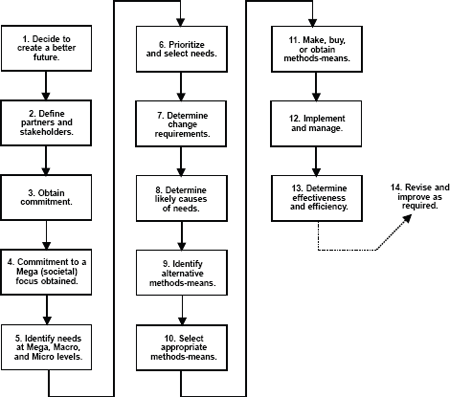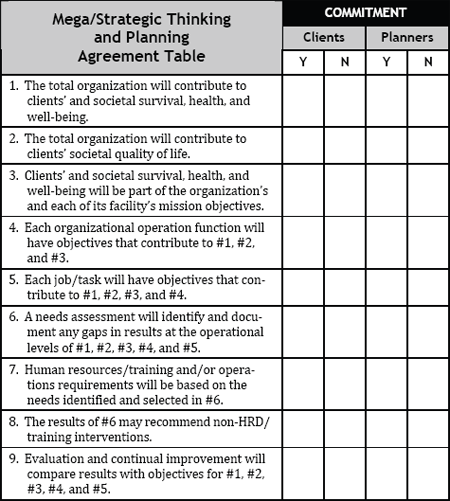14 Basic Steps for Defining and Delivering Success: Mega Thinking and Planning7
Figure 10.1 illustrates the 14 steps for thinking, doing, and delivering Mega results and consequences:
Figure 10.1. 14 Steps for defining and delivering Mega Thinking and Planning.
Let’s take a look at each step briefly.
Planning
Step 1. Decide to create a better future. Mega Thinking and Planning is about improving our shared world using ourselves and our organizations as the vehicle. This proactive approach— based on helping to create the kind of world we want for tomorrow’s child—is the single most important feature and is the primary “active ingredient” of this approach. It is also a unique approach.
Step 2. Define partners and stakeholders. Strategic thinking and planning should not be a lonely endeavor. If Mega Thinking and Planning is to add measurable value to our shared world, its development and implementation must be shared as well— shared with the people who will be impacted by it and the people who will implement it. Without “transfer of ownership,”8 any plans and resulting programs and activities will be at jeopardy.
Not only does everyone who will implement and receive the consequences of Mega planning have to “buy in” to its creations and its results, there must be sponsors for the planning activities and resulting plans. The higher up in the organization you can get sponsors, the better. The sponsor(s) should be in key decision-making roles and seen by all to have credibility and the ability to support the plans once developed.9
Sponsors, supporters, and participants should represent those who can and will be impacted by changes or failures to change. Don’t select people simply because they are friends or are politically connected. Everyone should know that Mega Thinking and Planning is bias-free.
Steps 3 and 4. Get commitment. No lip-service or passive support: get all the players to actually commit and sign off. The strategic thinking and planning agreement in Table 10.1. can get you started to make sure that all involved partners agree on Mega and the linkages among levels of results and consequences.
Step 5. Identify needs at the Mega, Macro, and Micro levels. Because organizations must link external client and societal contributions (Mega) with organizational contributions (Macro) and individual and small group contributions (Micro), needs— gaps in results—at each level must be harvested.
Needs at the Mega level should be based on the Ideal Vision (Figure 3.1), and these gaps in results will serve to provide you with the Mission Objective. The Mission Objective is the measurable statement of what your organization will deliver to move it ever-closer to the needs identified in the Ideal Vision. Figure 7.1 shows how the various levels are linked and related as you move from Mega to Macro to Micro.
Step 6. Prioritize and select needs. Because needs are gaps in results, prioritization should be done on the basis of costs-consequences assessment; the cost to meet the needs as compared to the costs for ignoring them. Needs should be prioritized at the Mega, Macro, and Micro levels. Guides for prioritizing selected needs are provided in Chapter 5.
Step 7. Determine change requirements. This step asks that you compare your current results and methods-means with the required ones so that you may identify what should be changed in your organization (results, resources, methods, etc.) and what you should keep and maintain. The priorities derived in step 6 above provide the criteria.
Step 8. Determine likely causes of the needs. Now that you have identified the changes and what should be continued, you can do an analysis of what is causing the gaps in results for the needs you want to reduce or eliminate. For example, current levees in New Orleans might contain the ravages of a category 3 storm and you want them to resist a category 4 storm. What are the causes of current failures? Politics, fraud, engineering, funding, commitment, cooperation, maintenance? This is where you find the reasons for the current priority gaps so that you can identify what must change.
Step 9. Identify alternative methods and means. Now you survey all of the possible ways and means to close the gaps in results—needs—you have selected and list the advantages and disadvantages of each. For example one methods-means would be government funding of levee reconstruction. An advantage would be in the immediacy of funds. A possible disadvantage could be that any funding would be wasted.
Doing
Step 10. Select the appropriate methods and means. This is getting into the implementation of the strategic/Mega plan. Based on costs-consequences (what you get and what you give) you pick the most effective and efficient ways and resources to meet the needs.
Step 11. Make or buy or obtain the methods and means. This is more of implementation; as the athletic footwear ads note “Just do it.” There are many performance design, development, and implementation approaches available for this.
Step 12. Implement and manage. Against the performance criteria developed earlier, ensure that everything stays on course, stays on schedule, and meets all requirements. If not developing appropriately, revise as required.
Step 13. Determine effectiveness and efficiency. This is a summative evaluation. You compare your results with your objectives and identify what worked and what did not, all based on measurable criteria and performance.
Step 14. Revise as required. Each short-fall is a friend in disguise, for it tells you what must be changed to deliver success. Evaluation (Step 13 above) should never be for blaming but fixing, and here is where the fixing can happen. Change what should be changed and keep what is working. This step is actually done both at this stage of planning and doing as well as at each of the previous steps.
Definitions of all terms are in the Glossary section at the end of this book.
Agreement is not a solitary enterprise. In a system, where all the parts interact and together move to a common and shared destination, it is vital that everyone agrees on Mega Thinking and Planning. In order to get everyone to commit to Mega Thinking and Planning, use the following agreement table in Table 10.1.
Table 10.1. An agreement table for Mega Thinking and Planning that can be used to gain consensus.10
Ask each person, including all internal and external stakeholders to actually “sign off” on each of their choices. Require that each person chooses “yes” or “no.” If someone has questions such as definitions or other problems, just tell them to sign “no” to that item. As you move through these questions, soon it will be apparent to all (except for the most intractable people who don’t get hung up on facts and reality), that Mega Thinking and Planning is essential for success.11


